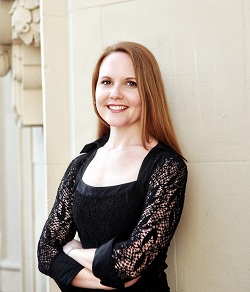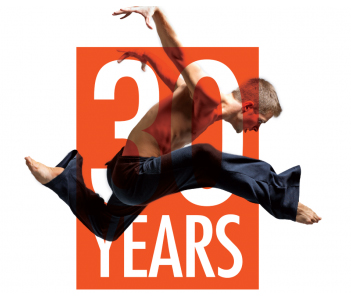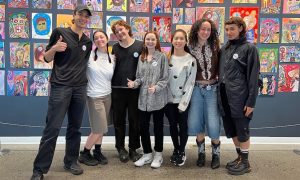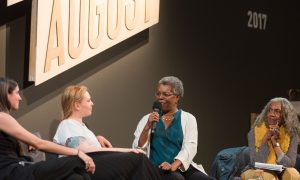By Emily Yewell Volin.
Dance/USA, established in1982, is a national dance service organization operating with the mission to do work that sustains and advances professional dance by addressing the needs, concerns, and interests of dance artists, administrators and organizations. A member organization serving over 400 dance companies, service and presenting organizations and individuals, Dance/USA enhances the infrastructure for dance creation, education, and performance. Based in Washington DC, Dance/USA also has branch offices in Philadelphia and New York City.
“In my 25 years of dance management, no single association has done more than Dance/USA to support my organization’s work through its advocacy, data gathering, and networking activities or played a more important role in my own professional development and that of our staff,” says Glenn McCoy, Executive Director of the San Francisco Ballet.
Amy Fitterer, Executive Director of Dance/USA since January 2011 has an infectious enthusiasm for the organization’s dedication to “embrace all things and move forward.” She spoke with Dance Informa regarding Dance/USA’s overarching goals, the people it serves, her personal background in the arts and Dance/USA’s exciting preparations for the 2012 conference during this, its 30th anniversary year. Amy says, “Dance/USA has made some very important strides over the years in advocacy and ensuring dance has had a place at the table in Federal policy discussions. Dance/USA is the sole member based national association for professional dance.”

Amy Fitterer, Executive Director, Dance/USA
What is your background and how does it impact your work as Executive Director of Dance/USA?
“I grew up training as a classical ballet dancer and also as a classical pianist. I allowed those two art forms to comingle and to impact my education and my career. I was able to run a small music school, perform as a concert pianist, and also perform in a regional ballet company in California until my late 20s. Then I became very interested in where art meets government. I decided to get a Masters in Arts Administration and went to Columbia University, which had Student Advocates for the Arts (it was founded there and is a national student-run arts advocacy network). Right before getting into Columbia I was active in everything I could get my hands on with advocacy and policy. I was able to interview a variety of city council members in NY on their arts policy backgrounds and platforms and I organized students to go to Albany to lobby for the NY State Council of the Arts. I also began to coordinate with Student Advocates For The Arts to come down to Washington to lobby on the federal level for arts policy. So, it was actually through my graduate studies and my work in government affairs that I encountered Dance/USA. I was hired after graduate school to be the Government Affairs Director for Dance/USA, which is a shared position with Opera America. So, for about 3 years, I was able to be on the Hill and at the Federal Government agencies speaking to members in the opera and the dance field around the country about federal advocacy issues. So I bring to this role both my hands-on experience in making art as a dancer and pianist but also my passion for policy.”
Dance/USA’s work is viewed in 3 umbrella categories: Leadership & Learning, Research, and Advocacy. Tell us more about Dance/USA’s work in these areas.
Dance/USA Advocacy:
“Dance/USA maintains a registered lobbyist on staff and we are a founding member of the Performing Arts Alliance, the national advocacy coalition representing over 28,000 members including dance, opera, orchestra, theater, arts presenters, chorus and so forth. Dance/USA has tracked a variety of issues with the coalition. The top issues we have always been paying attention to include visa policies for foreign guest artists, arts education, cultural exchange, charitable giving laws, and funding for the National Endowment for the Arts and the National Endowment for the Humanities. Recently, we’ve been lobbying on issues related to wireless microphones and the internet so we’ve been having meetings with the Federal Communication Commission. All of these policies impact the work that dance companies do in this country. Dance, in coalition with the rest of the performing arts, needs to have a seat at the table.”
How can people support the advocacy being done by Dance/USA?
“People can sign up to be part of the Dance Advocacy Network, a member listserve we have that sends timely advocacy information, including information about recent meetings on the Hill. They can respond to calls to action over email action alerts. Those do make a difference and legislative offices track those records and those responses. What’s also very important is that anyone working in the field of dance views themselves as an advocate, in the broadest sense, for the art form. And that they talk about their work not just with their friends and family but with other people they come across. We all have the responsibility on our shoulders to continue to raise the visibility and the recognition of the public value of our work.”
Dance/USA Leadership and Learning:
“Leadership and Learning goes back to the way Dance/USA was started, it creates a national network of dance leaders. One of our core membership structures is called ‘Councils’. We group our membership into different Council categories where managers, agents, artistic directors, students and educators can sit in a closed room discussion with their colleagues from another part of the country. They also get to participate in conference calls and listserves throughout the year.
Also, the national conference for professional dance (hosted by Dance/USA) is the largest annual convening of dance professionals in the United States. It includes a variety of keynote speakers, break out sessions, council meetings and dance performances and allows us to focus in on one dance city each year and really try to raise the visibility of dance in that city.
We also do professional development in this category throughout the year. Right now we have a partnership with NTEN, on a technology leadership training program for individuals in the dance field and a program called The Institute for Leadership Training, which allows for one-on-one coordinated mentorships with individuals across the country and participation in a leadership training seminar.”
Dance/USA Research:
“One of the longest standing programs of Dance/USA is the financial and data surveys it does each year. It allows participating dance companies who fill out these surveys to see a variety of data points compared across companies. They can see overall organizational expenses, how ticket revenue is doing and what shows are being performed. They can also look at staffing size, different staff and board and the breakdown of different revenue sources. It really allows a dance manager to check in and say, ‘Okay, how am I doing?’. It’s hard to work in a dance organization because you can feel very isolated. So, to be able to stop and see how you compare to a fellow dance organization of the same budget size is very informative.”
 Tell us more about this year’s Dance/USA conference, which will convene in San Francisco from June 27-30.
Tell us more about this year’s Dance/USA conference, which will convene in San Francisco from June 27-30.
“This year’s Dance/USA conference celebrates 30 years by looking forward and moving forward; change is now the norm. So, with this year’s conference our goal is to embrace trying new things. We’re partnering with Yerba Buena Center for the Arts and ODC Dance Commons so all our conference sessions, breakouts and performances will be held in arts venues (dance studios and theaters), rather than in a conference hotel. We are trying to bring the art form more front and center so we have a dance performance during the day that everybody at the conference can attend. We are getting proposals, booking speakers, and coordinating with the host company in San Francisco to decide the themes and threads we want to touch upon. I’d say the three threads that have come out so far are diversity, community partnerships and technology. We have a great keynote speaker, Simon Sinek, who not only loves dance but has really innovative approaches to leadership. I know he is really excited to work with the dance community.”
Learn more about Dance/USA and this year’s conference at www.danceusa.org and www.conference.danceusa.org















